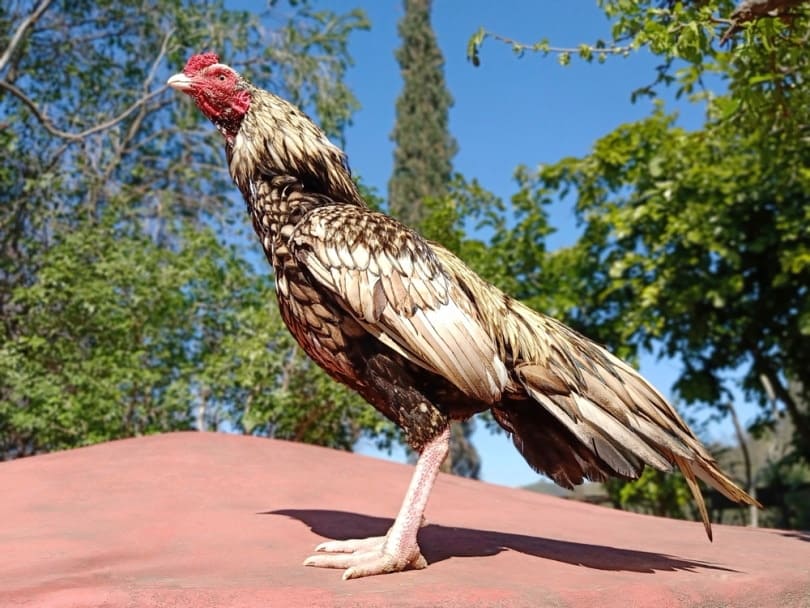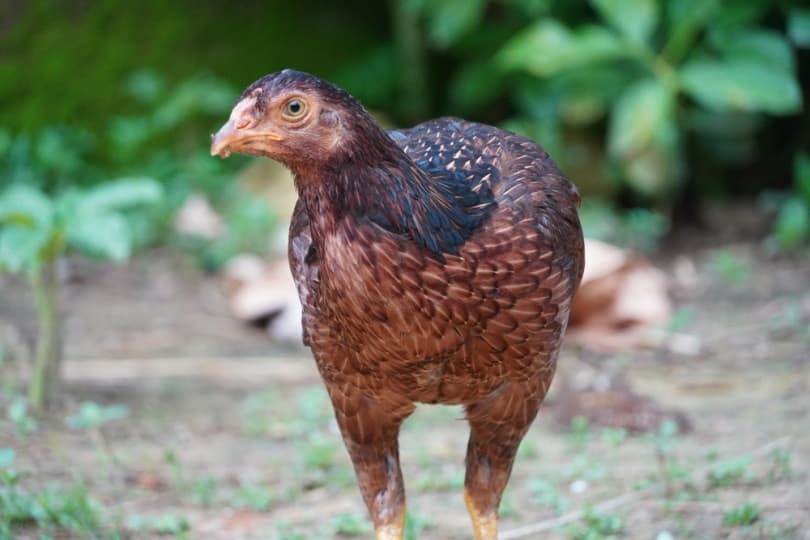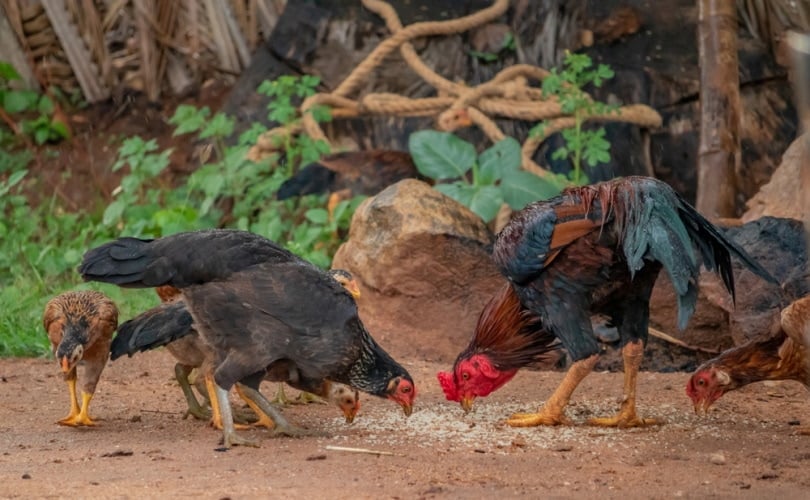If you really want to turn heads, adding an Asil chicken to your flock will definitely do the trick. These game chickens are incredibly unique in structure, purpose, and personality.
If you are a first-time chicken keeper, we highly recommend steering clear of these fowl as they are aggressive and rambunctious. So, if they aren’t good flock members, what on earth are they used for? We’re glad you asked! Let us tell you below.

Quick Facts About Asil Chickens

| Breed Name: | Aseel/Asil |
| Place of Origin: | Southeast Asia |
| Uses: | Exhibition |
| Rooster Size: | 4-6 pounds |
| Hen Size: | 3-5 pounds |
| Color: | White, red wheaten, fawn, wheaten, gray |
| Lifespan: | 10 years |
| Climate Tolerance: | Cold and heat hardy |
| Care Level: | Moderate |
| Production: | Ornamental only |
| Temperament: | Aggressive |
Asil Chicken Origins
The Asil, otherwise spelled Aseel or Azeel, is a chicken highly revered in their line of work—cockfighting. In Southeast Asia, this breed is praised by those who fancy the sport, as they remain the highest acclaimed fighters of their kind.
The earliest documentation of the breed originated in ancient India in the manuscripts of the Code of Manu. So, while there is some speculation between India and Pakistan giving birth to these champions, we know they came from Southeast Asia for certain.
They quickly gained some traction, first making it to Europe in the year 1750. Excellent in muscle structure, agility, and brute strength, these birds became quite golden tickets for keepers, generating avenues for income in cockfighting.
By the mid-to-late 1800s, they made their way across Europe to land on American soil. Even though these birds evoke quite a poultry appreciation from people, they aren’t so common. They are deemed threatened by the Livestock Conservatory Priority List.
Even though these chickens have years of cockfighting history, they remain an ornamental breed in most modern cultures.


Asil Chicken Characteristics
Asil chickens are incredibly keen and watchful, being cautiously aware of their surroundings. This is definitely an aggressive chicken breed—both with birds and sometimes humans. They have a lot of pent-up energy which often presents as intimidating or domineering.
Asil hens are more likely to get along with a flock, but they still might be very dominant and bossy with the girls. Multiple roosters can cause a real problem—sometimes fighting to the death or causing hefty wounds that have trouble healing.
Hens are not particularly good layers, but they tend to go broody often and make excellent mothers—even sometimes to eggs that are not theirs. This trait is surprising, given their rowdy nature.
Asil chickens have fighting deeply rooted in their DNA. In fact, it’s so deeply rooted that chicks often start fighting and bullying very early on. So, if you have Asil chicks, it’s advisable to keep them apart from other breeds.
Despite their rather aggressive nature toward other fowl and barnyard animals, they can be very friendly toward people. While it’s possible to get a grumpy Asil who doesn’t like anyone—human or animal—it’s also possible to get a very tamable and rather affectionate Asil.
It isn’t unusual to see an Asil attack another chicken relentlessly, only to turn around and come running after their human for scratches and snacks.
Uses
In the old days, and still, in some countries, Asil chickens were the masters in the cockfighting ring. Today, however, these birds are kept for ornamental purposes.
Even though they kick butt and take names, they are not too efficient at anything else other than looking exceptionally beautiful.
Roosters can be adequate flock protectors, but they also might be a little aggressive with hens and most certainly territorial with other cocks.
Hens can get along with other hens, though they might be dominant. They tend to be very broody, taking in and sitting on eggs quite naturally. So, they are a suitable species to have if you plan to hatch.
These chickens aren’t very meaty, though they are quite muscular. While these birds are tall and extravagant, they are pretty thin and would be described as gamey.
They aren’t magnificent layers either—usually topping out around 70 eggs per year. These eggs range from cream to brown and are pretty small.

Appearance & Varieties
The Asil is considered an ornamental bird, meaning many keepers own them for their visual appeal and not so much for their practicality.
Full-grown roosters and hens are real head-turners, with deeply iridescent feathers and elongated, toned bodies. Roosters have sloping tail feathers that give a lovely sweeping aesthetic.
Hens have a significantly shorter set of tail feathers, but they still slant downward in response to their body shape. Hens are slightly smaller with the same body structure as their male counterparts.
Both genders have noticeably shorter combs than many other breeds.
Asil chickens can come in a variety of colors, often including multicolored plumage. Base colors include:
- White
- Red wheaten
- Fawn
- Wheaten
- Grey
Population/Distribution/Habitat
Though Asil chickens are spread practically worldwide, they remain pretty sparse in the chicken world. So, this chicken remains on the threatened list, being likely very rare in your area.
Some hatcheries offer online purchasing where baby chicks are sent to your doorstep. Keep in mind that not every hatchery sexes the chicks and also has a minimum order limit.
Keep in mind that Asils can be very aggressive, especially when multiple roosters are involved in the equation. Be mindful of separating any squabbling chicks to prevent injuries and even death from fighting.


Are Asil Chickens Good for Small-Scale Farming?
In most circumstances, Asil chickens are not at all good for small-scale farming. These chickens require experienced chicken owners who know how to handle potential aggression, keeping the flock and others safe.
While many keepers would consider their Asil more confident than aggressive, the possibility of immense aggression still exists within the breed. So, caution is advised, and proper measures should be taken to ensure the safety of your birds and the beautiful Asil.
Featured Image Credit: REHAN HUSSAIN IMAM, Shutterstock
